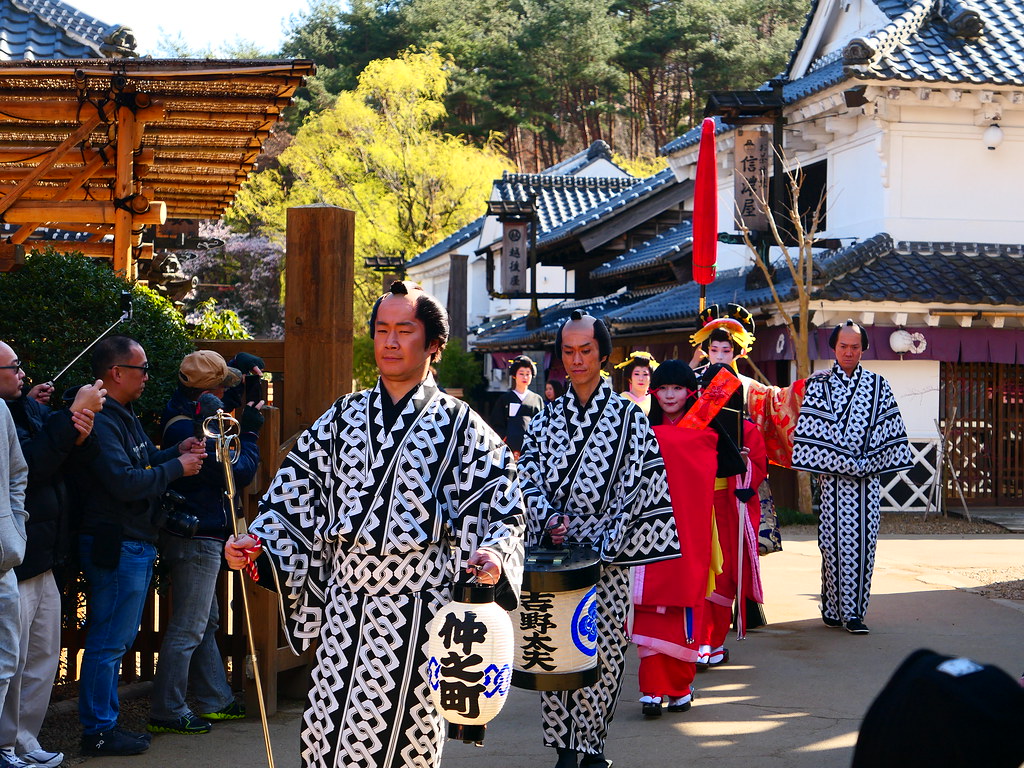
In the early afternoon at Edo Wonderland, the staff will direct everyone towards the main strip in the village for the Oiran Dochu parade (or the Oiran Courtesan Procession).
This one is interesting because many will think this is a parade for a geisha, but many people do not know the true meaning of this parade back then.
Back in the Edo Period, Oiran (courtesans in Japan) were classy version of yujo (women of pleasure/prostitutes) that were more entertainers and even celebrities in their village outside the usual pleasure district areas. They were known for their art and fashion trend and were expensive and did not participate in sexual favors but for entertainment for the wealthy.
Now it’s important to mention that Oiran and Geisha are similar in look, but they are very, very, very different.
Geisha perform ancient traditions of art, dance and singing. They were specialized as entertainers and back in the early day, the first geisha were actually men who were customers to see the more popular and gifted courtesans, the oiran.
Female geisha would begin later as teen odoriko (dancing girls) and they were popular paid entertainers in the private homes of upper-class samurai. They were known for their grace.
Oiran are often confused with geisha because they dressed similarly but back then they were high-class yujo. During the Edo Period, laws were passed restricting brothels to pleasure quarters (yukaku), which were walled districts. Yujo were prostitutes that provide sexual favors, the Oiran were courtesans who were entertainers that performed in sado (Japanese tea ceremony), ikebana (flower arranging) and calligraphy. They also learned to play the koto, shakuhashi, tsuzumi and shamisen (all traditional Japanese instruments).
Their prestige was based on their beauty, character, education and artistic ability. They spoke in formal court standards than regular common language and were decorated with pins or combs in their hair or ornamented garments.
But the rise of the geisha ended the era of the oiran. Where oiran performed for clients that were referred to them by certain tea houses or via appointment, they were expensive and there was a waiting list. For geisha, they weren’t as formal and more approachable and what they provided entertainment wise fit the average person’s taste and they were also less expensive than oiran. So, by the 19th century, geisha would replace oiran as the companion of choice of wealthy Japanese men.
But there is a myth created in the west because they assumed that geisha and oiran were sexual prostitutes because they co-existed with yujo (sexual prostitutes) in Yoshiwara in Edo (Tokyo), Shimabara (Kyoto) and Shinmachi (Osaka).
The Oiran Dochu Parade (which is about 20 minutes long) was actually quite interesting to see because it’s part of Japanese tradition that you don’t see happening anymore (Bunsui, Niigata still hosts one once a year in April and in Senzoku, which was Yoshiwara back in the day, north of Asakusa in April).
They were actually done everyday back in the Edo Period, as they were considered as events to advertise the various houses. For rich merchants to sit and drink with an oiran and not realize that a 10-minute session would cost them a lot of money and left some in financial ruin. While the parade exists more as a reminder of the heyday of the past, the tradition of hosting for drinks still exist in Japan as host clubs still exist in Japan and the practice of beautiful women (and also guys) trying to get people to drink and spend an insane amount of money.
You will read stories today of unsuspecting men who see a beautiful woman who entice them to drink and find out their credit card was charge hundreds to thousands of dollars. This happened back then in the Edo Period and kabuki plays detailing men who found themselves broke for awhile after drinking with an oiran.
While major Oiran Dochu Parades that continue today are only done in April, and I was there during the Spring cherry blossoms in April, the parade at Edo Wonderland takes place everyday the theme park is open.
Of course, it’s smaller than a real Oiran Dochu Parade which features 70 accompany servants. This one has less than a dozen (while the other staff are there to maintain crowd control and that is to make sure there is space for them to walk).
This Oiran Dochu Parade at Edo Wonderland, there are four oiran but the taiyu is featured in very tall wooden clogs crossing from one side to the other. Because it takes a long time for one to walk with those clogs, if you want to take a picture, stay towards the front area of the parade, and when they pass you, go towards the ending spot of the center and you can get even better photos.











This is definitely one of the coolest things to see at Edo Wonderland. So, have your cameras read in the early afternoon!
